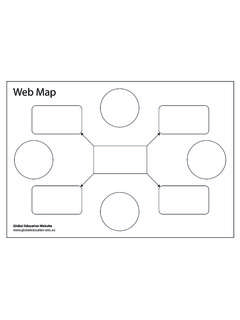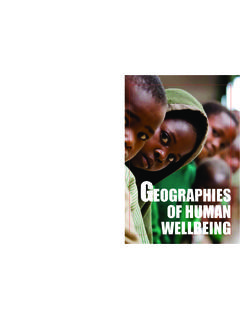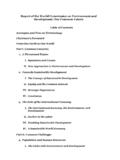Transcription of A secondary school geography teaching resource …
1 A secondary school geography teaching resource for Years 7 to10. 1. ISBN: 978-0-9872763-2-2. Published by: One World Centre (Global Education Project). Commonwealth of Australia, 2014. Creative Commons-Non-Com-Share Alike Australia license, as specified in the Australian Government Open Acess and licensing framework 2011. Some rights reserved. This project was funded by the Australian Government's Department of Foreign Affairs and Trade. (DFAT). Written by: Nuella Flynn Graphic Design by: Thanks also to: Kylie Hosking, Cameron Tero, Orla Hassett, Alison Bullock, Jenni Morellini and Genevieve Hawks. Cover photo: Chowpatty Inequality Image by Shreyans Bhansali (CC BY-NC-SA ). About the photo: A child looks across the bay at Nariman Point, Mumbai, some of the most expensive land in the world. The views expressed in this publication are not necessarily those of the Global Education Project, or the Australian Government.
2 2. Contents Introduction .. 2. Year 7 Community .. 4 Curriculum Links .. 5. Rumour Clinic .. 6 What makes a community liveable? .. 8 Examining liveability in communities experiencing poverty .. 11 Views of the local community .. 14 Improving community liveability .. 15 Australian Government efforts to build community .. 16 Drawing conclusions .. 17 Year 8 Urbanisation .. 18 Curriculum Links .. 19. Global urbanisation trends .. 20 Background on Bangladesh .. 22 Field Trip to Dhaka .. 23 Examining causes of urbanisation .. 30 Global Citizens making a difference .. 32 Year 9 Trade .. 36 Curriculum Links .. 37. Where do they come from? .. 38 Global trade connections game .. 39 Everything has a biography .. 41 International trade and poverty .. 43 Trading fair diamond ranking .. 46 Year 10 Wellbeing .. 47 Curriculum Links .. 48. Talking about world regions .. 50 Modelling the state of the world.
3 52 Sustainability and the wellbeing of the planet .. 54 Many ways to measure wellbeing .. 55 Considering diverse perspectives .. 57 Exploring relationships: poverty, literacy and gender equality .. 59 Taking action online .. 60 How can I act? .. 61 How do government and non-government organisations respond? .. 63 Thinking about the future .. 65. Communities photo set information .. 66. References .. 68. Poverty A Global Priority The role of a geographer is to ask questions about the earth 's physical and cultural environment, to explore how people and places interact with each other and why and how these interactions change over time. This book will use geographical skills to guide your students through the numbers, pictures and stories, helping them to see who is affected by poverty and how, where change is happening and why, and the vital role an individual citizen can play by making poverty a priority in their lives.
4 XXPoverty is experienced by people in every country of our global community. Around the world there are: XXseven billion people (and climbing)1, XXfifty one ongoing armed conflicts2, XX19,000 children a day not living to age 53, and XXone in five people living in extreme poverty, having less than US$ a day to live on. What do these numbers tell us of our priorities? Is poverty a priority? And, if it is not, are our priorities poor? There is also a hopeful story not told by these numbers: The rate of poverty is falling and people all around the world are committed to positive change. Change and progress are happening every day. Defining poverty A person's income is the most commonly used indicator where people would fall below the accepted standard of of poverty. Internationally, extreme poverty is widely living in that society. This is also sometimes referred to as accepted to be having less than US$ a day to live on.
5 Living below the poverty line. This is also frequently referred to as absolute poverty . To understand the varied nature of poverty it is important which strictly means the level of income where someone to think beyond purely economic aspects to the social, is unable to meet his or her basic needs for food, clothing, political and cultural context in which it is experienced. shelter and education. These measures fail to recognise Broad thinking about poverty also considers how it that poverty can be experienced when people are unable contravenes human rights, such as the right to work, to participate fully due to vast inequality within a particular to have an adequate income, to access healthcare society. This has led to the concept of relative poverty that and education, to freedom of thought, expression and defines poverty for a particular country as a proportion of association, and the right to maintain a cultural average income.
6 Relative poverty is a measure indicating Responding to the challenge Countries around the world have agreed on a set of global XXwell-regulatedeconomic growth that creates jobs with targets for reducing poverty and addressing its causes adequate incomes accessible to all;. and impacts. The Millennium Development Goals have XXsocial policies that are grounded in universal human set out measurable goals, such as halving the proportion rights; and of people living in extreme poverty, providing universal XXpolitical structures that protect and encourage active primary education, and reducing child mortality by two- citizenship, ensuring those in poverty have a voice and thirds with the aim of achieving these goals by 2015. responding to the needs of all citizens. Some of the targets have been already been reached but Such approaches consider the institutions, policies and many have not.
7 Political structures that contribute to poverty and prevent its reduction. While there is no one right way to eradicate So what does it take to combat poverty? While we poverty, effective strategies consider the important links frequently hear about programs and services targeting between equality, economic growth, social policy, and those living in poverty, research6 suggests the vital good governance. elements of approaches to eradicate poverty are much broader. There is a role for each of us to play. Governments can make poverty a priority by allocating funding to areas that These elements include: reduce poverty, such as health and education. Wealthy 2. Poverty A Global Priority (cont.). nations can increase their aid allocations to poor nations this world must face the challenge of sustaining their and make economic policies which favour poverty environment for current and future generations in a alleviation.
8 Individual citizens and groups can also play planet with a large and growing population. Our actions an active role in having a voice, holding governments and must be measured, our steps must be considered, and each other to account, and considering how their actions new ways to limit our demands on the planet must be impact on their fellow global citizens. found. More sustainable resource use can result from the complementary outcomes of poverty reduction, economic Tied to the challenge of social development is the ever- progress, slower population growth and environmental present challenge of shrinking resources that are needed, protection. We all have a responsibility to consider the or at least wanted, to service a growing economy. With issue of how the world can provide enough for all, and to growth comes consumption, and the consumers of grapple with the complexity of the solutions.
9 The Poverty Priority Using this resource So what does that mean for educators? What particular experience of poverty. The material that follows includes role can they play? four structured inquiries that address the Australian Curriculum: geography in Years 7, 8, 9 and 10, as well as Children rank school as one of their most important a number of general capabilities and cross-curriculum sources of information about This resource priorities. provides schools with quality information about poverty and effective strategies to address it. It can help The curriculum links listed in this document are the ones teachers to make poverty a priority in their classes and most closely related to each activity, but the list is not shape active citizens with the skills and motivation to exhaustive and there may be links to other areas which make a difference. The Australian Curriculum supports are also fulfilled by these lesson ideas.
10 To find out more educators in this role by emphasising the importance of about each of the content descriptions written in the global citizenship. Equity and justice are at the heart of curriculum tables, click the hyperlink or enter their code in sustainable societies and sustainability is a priority area the search window at: of the Australian Curriculum. The inquiries in this resource will help to develop a broad The Poverty Priority is a global education resource , view of poverty by considering the many factors that guided by the principles of Global Perspectives: A contribute to our wellbeing as individuals and as a society. Framework for Global Education in Australian Schools8. From this deepened understanding students will make Enabling young people to participate in shaping a better connections between their own life and the lives of people shared future for the world is at the heart of global in different circumstances, reflecting on what it means education.







